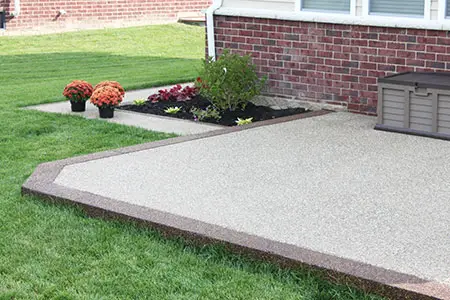You would have surely seen decorative driveways, sidewalks and patios and perhaps wondered how they are achieved. Those are achieved by using exposed aggregate concrete. Those floors are done by removing the top layer on concrete from a surface to reveal the color and texture of aggregate beneath it. Exposed concrete floors are durable and provide skid resistance.
ADVANTAGES OF EXPOSED AGGREGATE CONCRETE
There are both pros and cons of using exposed aggregate concrete. The advantages include:
- Get gorgeous decorative effects at an affordable cost as very few additional materials are needed. You may will only need some decorative aggregates, surface retardant, sprayer and a garden hose. So, exposed aggregate concrete is not expensive.
- The construction procedure is quite simple and anybody experienced in handling concrete can do it.
- The surface is weather resitant, lasts long and also skid resistant.
- There are variety of decorative aggregates like small or large size, round, colored etc available.
- It suits with the other decoratives around.
- No additional maintenance except occasional cleaning with water and resealing every few years.
Related: Exposed Aggregate Patio
HOW TO DO
Here are the three ways of having aggregate exposed concrete:
Monolithic – This is the easiest and hence the most popular way of making such floors. The aggregate is batched into concrete at the time of making concrete. Smaller aggregate known as ‘pea stone’ is generally used.
Seeded – Soon after concrete is laid, the decorative aggregate is mechanically or manually placed over the surface of concrete and floated by hand.
Overlay – This method is suitable for already existing concrete in good health. Aggregate is mixed in the overlay material and applied over the old concrete to give it a new look.
In any case, the top layer of the cement paste is kept soft while the concrete below it hardens. This is done by spraying a retardant on the surface immediately after concrete and aggregate have been installed. Subsequently, the cement paste is washed clean using a garden hose or pressure washer to expose aggregate on the surface. You can read this post about making exposed aggregate concrete.

DISADVANTAGES OF EXPOSED AGGREGATE CONCRETE
While an exposed aggregate concrete adds color to front yard or driveway and looks exclusive and ornamental, compared to concrete slab, you need to consider its limitations before installing one. The disadvantages of exposed aggregate concrete is listed below.
Durability
Though exposed aggregate can be tough and long lasting as long as the concrete holds together the aggregate, the decorative stones on top are prone to damage. Movement of heavy objects and water damages can dislodge or loosen the stones close to the surface to create small pits therein. And, once the process starts, the damage spreads pretty fast as surface water deteriorates the bond between the concrete and aggregate.
Repairs
Repairing a part of such floor is more difficult, compared to repairing cracks in concrete floors. The toughest part is blending of the patched surface with the rest of the floor. You may tint the patch of concrete to go with the older concrete and then fill that hole as in case of concrete surface. Avoid using excessive amount of compound to fill the hole to make easy the leveling of the affected part with the rest of the floor. Subsequently, add stones to the new concrete. You’ll need to find aggregate that best matches with your existing surface.
Maintenance
Cleaning exposed aggregate is certainly more difficult than cleaning of concrete slab that can be hosed off. Dirt and debris gets stuck between its surface, necessitating using wire brush or powerful jet of water for their removal. Whether you have exposed aggregate surface on the walkway, driveway or patio, it needs sealing once in two years to enhance its life and strength.

Nevertheless, on comparing with other decorative concrete styles; it is realized that exposed aggregate concrete offers an economical way of having a great looking decorative concrete look.
